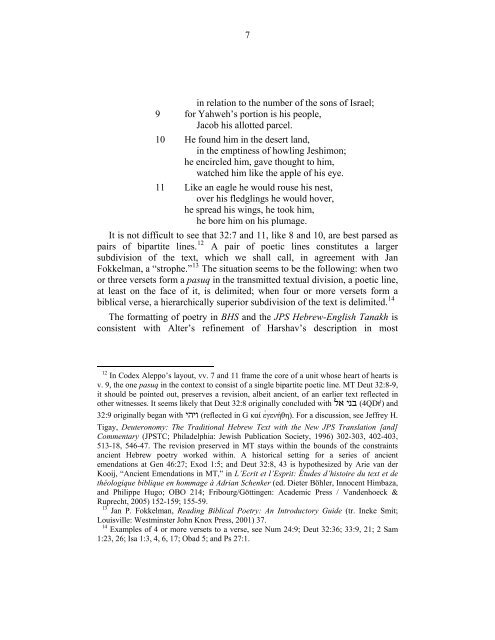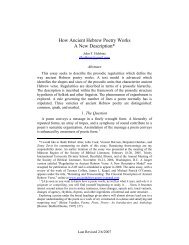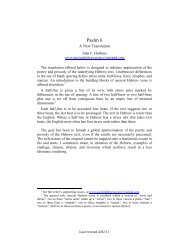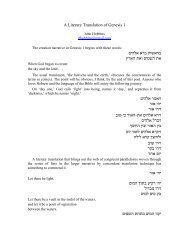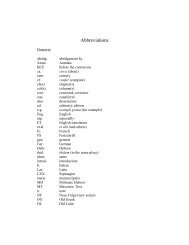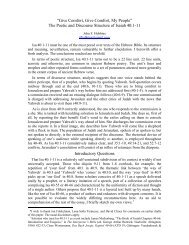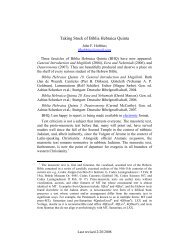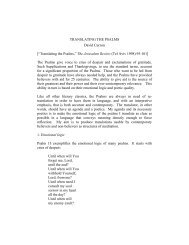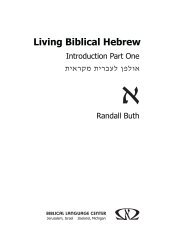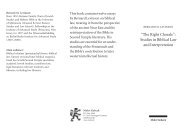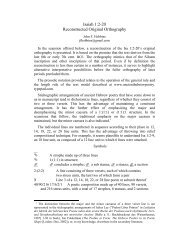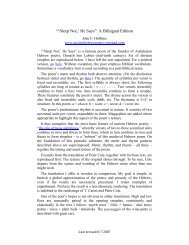Here - Ancient Hebrew Poetry - Typepad
Here - Ancient Hebrew Poetry - Typepad
Here - Ancient Hebrew Poetry - Typepad
- No tags were found...
Create successful ePaper yourself
Turn your PDF publications into a flip-book with our unique Google optimized e-Paper software.
7in relation to the number of the sons of Israel;9 for Yahweh’s portion is his people,Jacob his allotted parcel.10 He found him in the desert land,in the emptiness of howling Jeshimon;he encircled him, gave thought to him,watched him like the apple of his eye.11 Like an eagle he would rouse his nest,over his fledglings he would hover,he spread his wings, he took him,he bore him on his plumage.It is not difficult to see that 32:7 and 11, like 8 and 10, are best parsed aspairs of bipartite lines. 12 A pair of poetic lines constitutes a largersubdivision of the text, which we shall call, in agreement with JanFokkelman, a “strophe.” 13 The situation seems to be the following: when twoor three versets form a pasuq in the transmitted textual division, a poetic line,at least on the face of it, is delimited; when four or more versets form abiblical verse, a hierarchically superior subdivision of the text is delimited. 14The formatting of poetry in BHS and the JPS <strong>Hebrew</strong>-English Tanakh isconsistent with Alter’s refinement of Harshav’s description in most12 In Codex Aleppo’s layout, vv. 7 and 11 frame the core of a unit whose heart of hearts isv. 9, the one pasuq in the context to consist of a single bipartite poetic line. MT Deut 32:8-9,it should be pointed out, preserves a revision, albeit ancient, of an earlier text reflected inother witnesses. It seems likely that Deut 32:8 originally concluded with בני אל (4QDt j ) and32:9 originally began with ויהי (reflected in G καί ε̉γενήθη). For a discussion, see Jeffrey H.Tigay, Deuteronomy: The Traditional <strong>Hebrew</strong> Text with the New JPS Translation [and]Commentary (JPSTC; Philadelphia: Jewish Publication Society, 1996) 302-303, 402-403,513-18, 546-47. The revision preserved in MT stays within the bounds of the constraintsancient <strong>Hebrew</strong> poetry worked within. A historical setting for a series of ancientemendations at Gen 46:27; Exod 1:5; and Deut 32:8, 43 is hypothesized by Arie van derKooij, “<strong>Ancient</strong> Emendations in MT,” in L’Ecrit et l’Esprit: Études d’histoire du text et dethéologique biblique en hommage à Adrian Schenker (ed. Dieter Böhler, Innocent Himbaza,and Philippe Hugo; OBO 214; Fribourg/Göttingen: Academic Press / Vandenhoeck &Ruprecht, 2005) 152-159; 155-59.13 Jan P. Fokkelman, Reading Biblical <strong>Poetry</strong>: An Introductory Guide (tr. Ineke Smit;Louisville: Westminster John Knox Press, 2001) 37.14 Examples of 4 or more versets to a verse, see Num 24:9; Deut 32:36; 33:9, 21; 2 Sam1:23, 26; Isa 1:3, 4, 6, 17; Obad 5; and Ps 27:1.


